Abstract
Metabolic clearance (MCR) and production rates (PR) of human thyrotropin (hTSH) were determined by the constant infusion to equilibrium method 57 times in 55 patients. 16 control patients had a mean hTSH MCR of 50.7 ml/min. The mean hTSH MCR was significantly (P < 0.02) higher in 19 euthyroid men (51.6 ml/min) than in 12 euthyroid women (43.0 ml/min), but this apparent sex difference disappeared when the MCR were corrected for surface area, 25.8 (men) versus 25.2 ml/min per m2 (women). Hypothyroid patients had significantly (P < 0.005) lower hTSH MCR (30.9 ml/min), and hyperthyroid patients had significantly (P < 0.05) higher hTSH MCR (60.9 ml/min) than controls. The hTSH MCR in patients with “decreased thyroid reserve” (40.9 ml/min), hyperfunctioning thyroid nodule (53.8 ml/min), and “empty sella syndrome” (46.6 ml/min) were not significantly different from controls. The mean hTSH PR in controls (104.3 mU/day) was significantly (P < 0.005) different from that in patients with “decreased thyroid reserve” (956 mU/day), hypothyroidism (4,440 mU/day), hyperthyroidism (< 43.9 mU/day) and a hyperfunctioning thyroid nodule (< 38.7 mU/day). In primary hypothyroidism intravenous triiodothyronine therapy (50 μg/day) for 10 days decreased the hTSH PR (from 4,244 to 2,461 mU/day) before changes in the hTSH MCR (from 33.1 to 33.7 mU/day) were observed.
These studies have demonstrated that changes in the serum concentration of hTSH are mainly due to altered pituitary hTSH secretion with only a minor contribution from the change in hTSH MCR.
Full text
PDF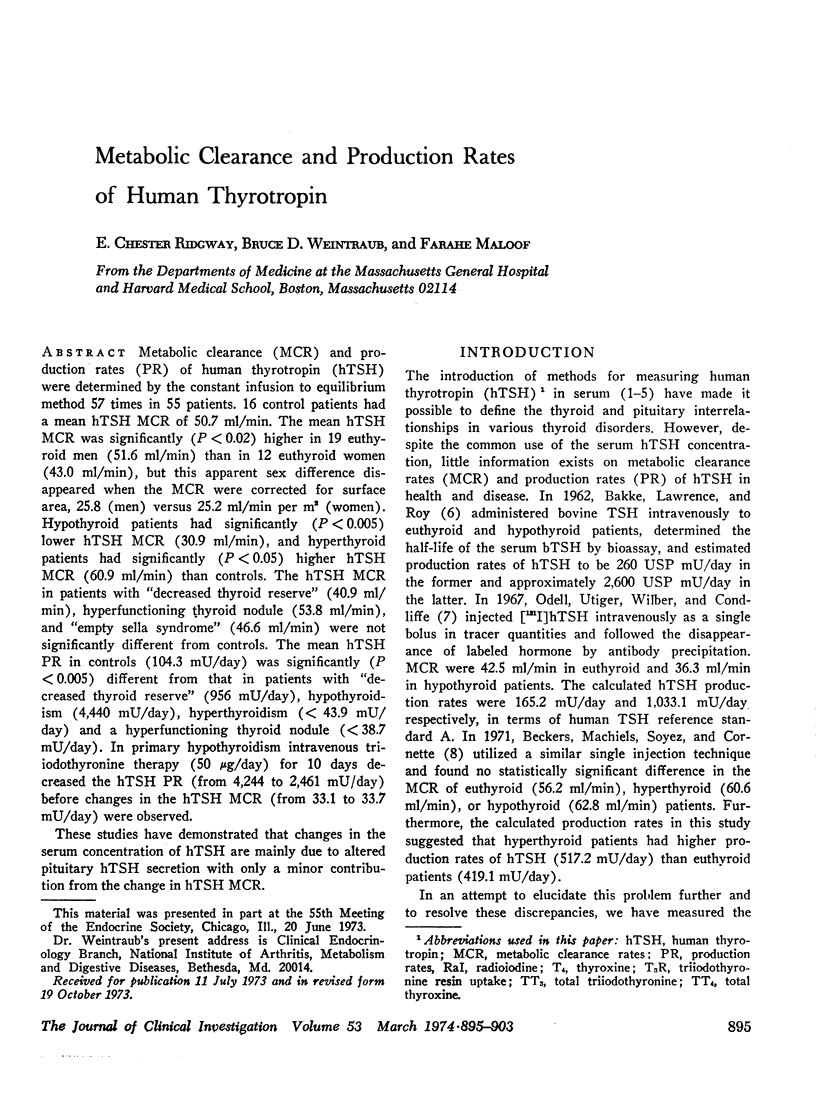
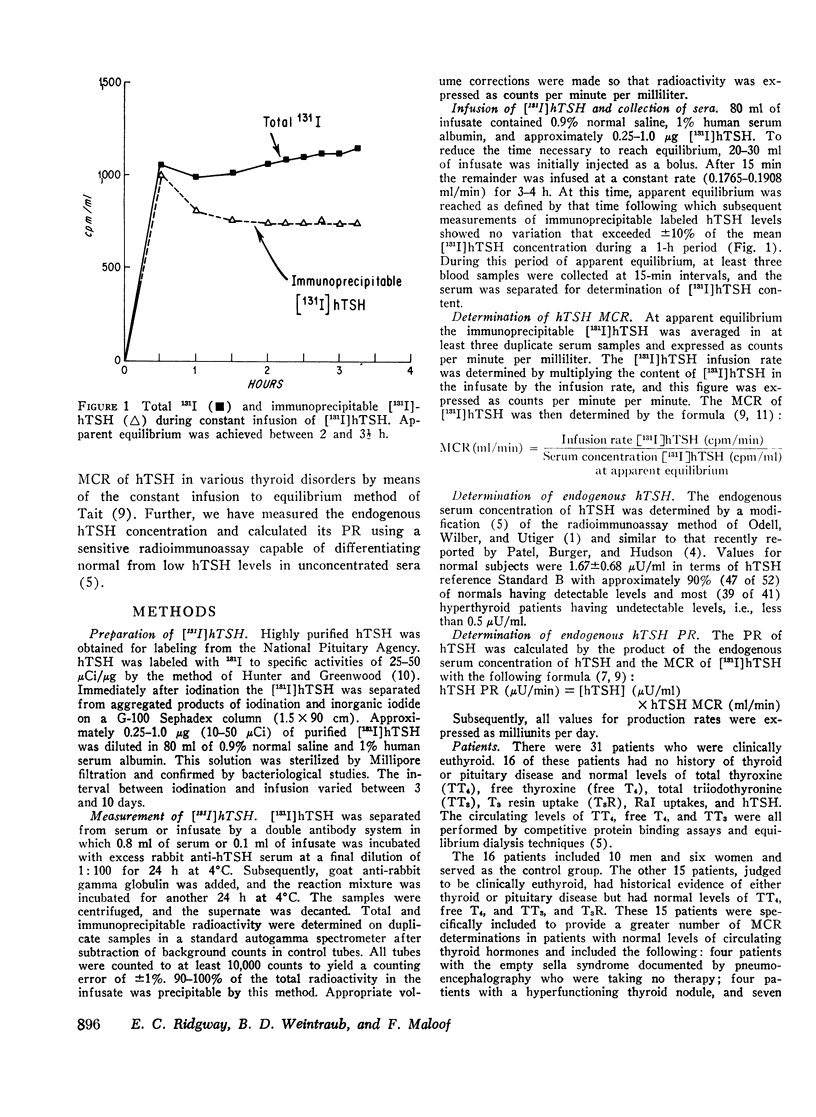
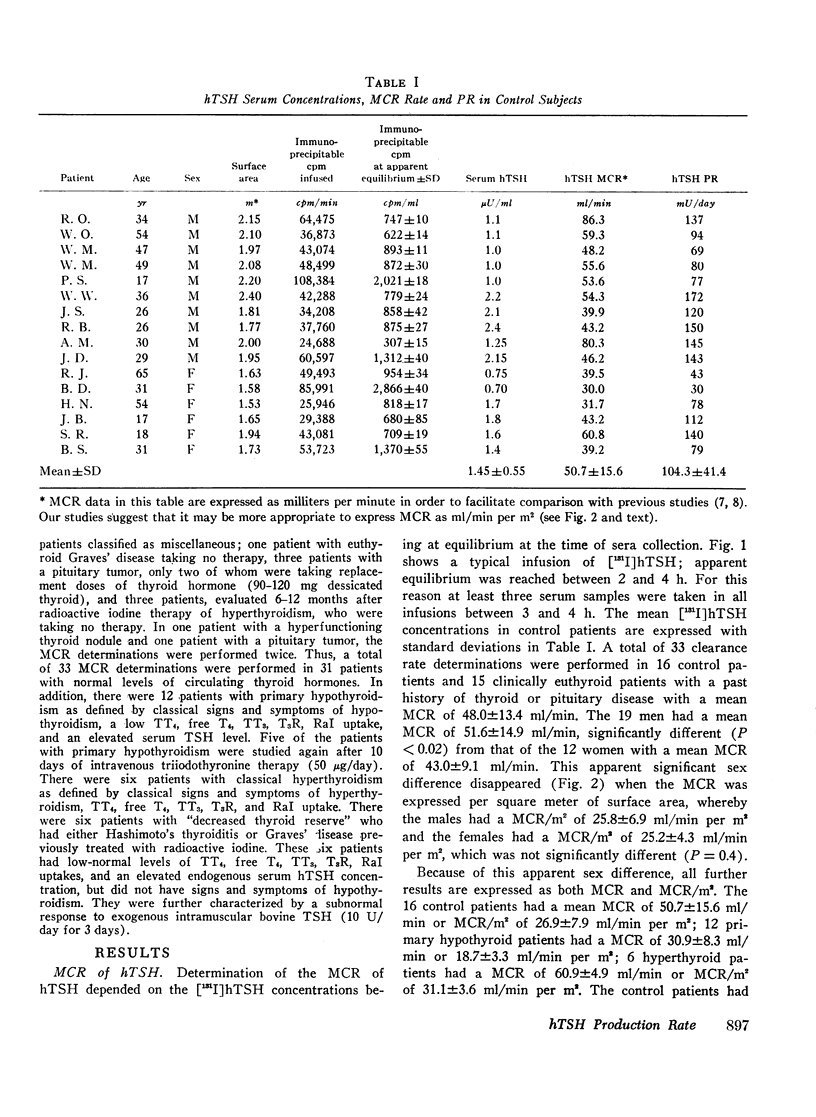
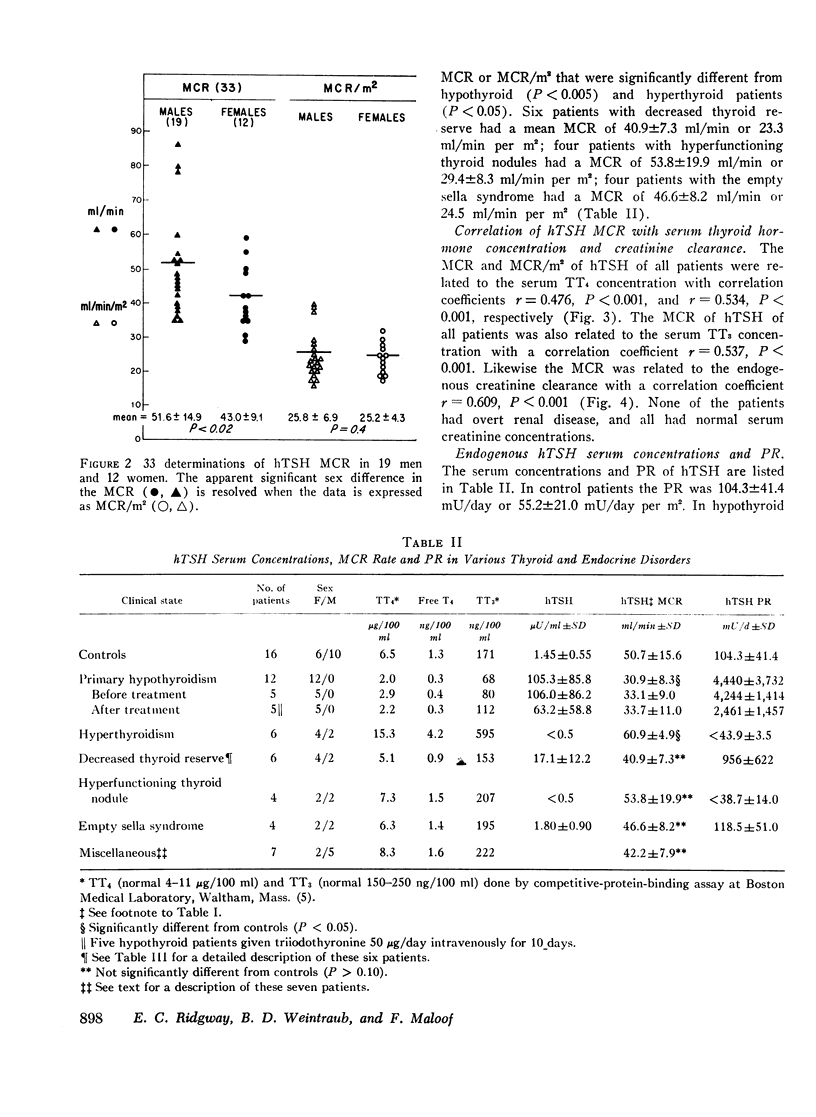
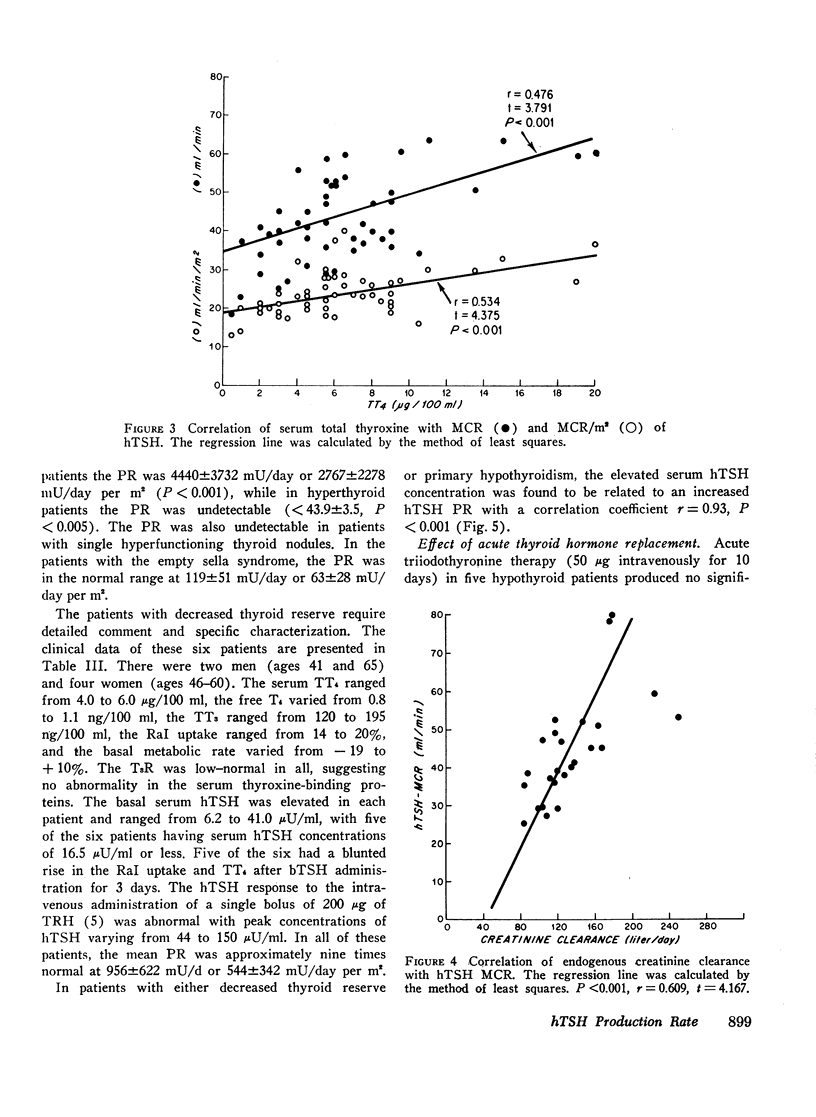

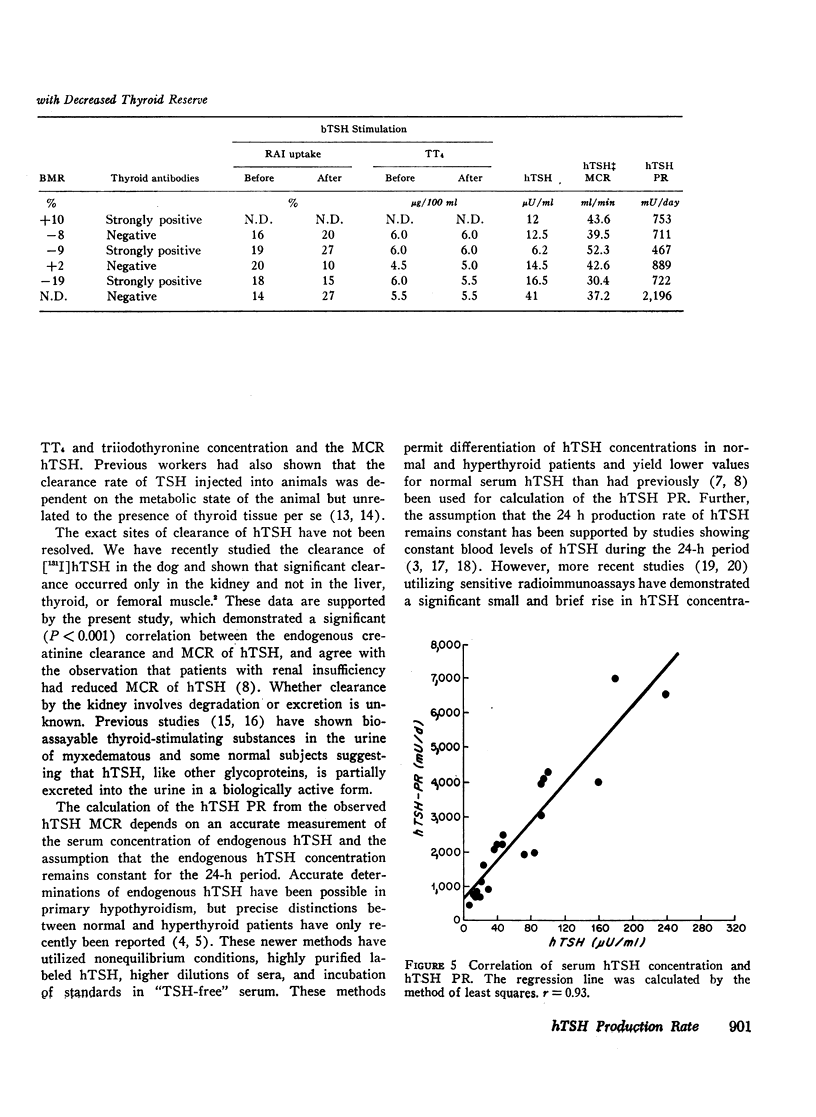

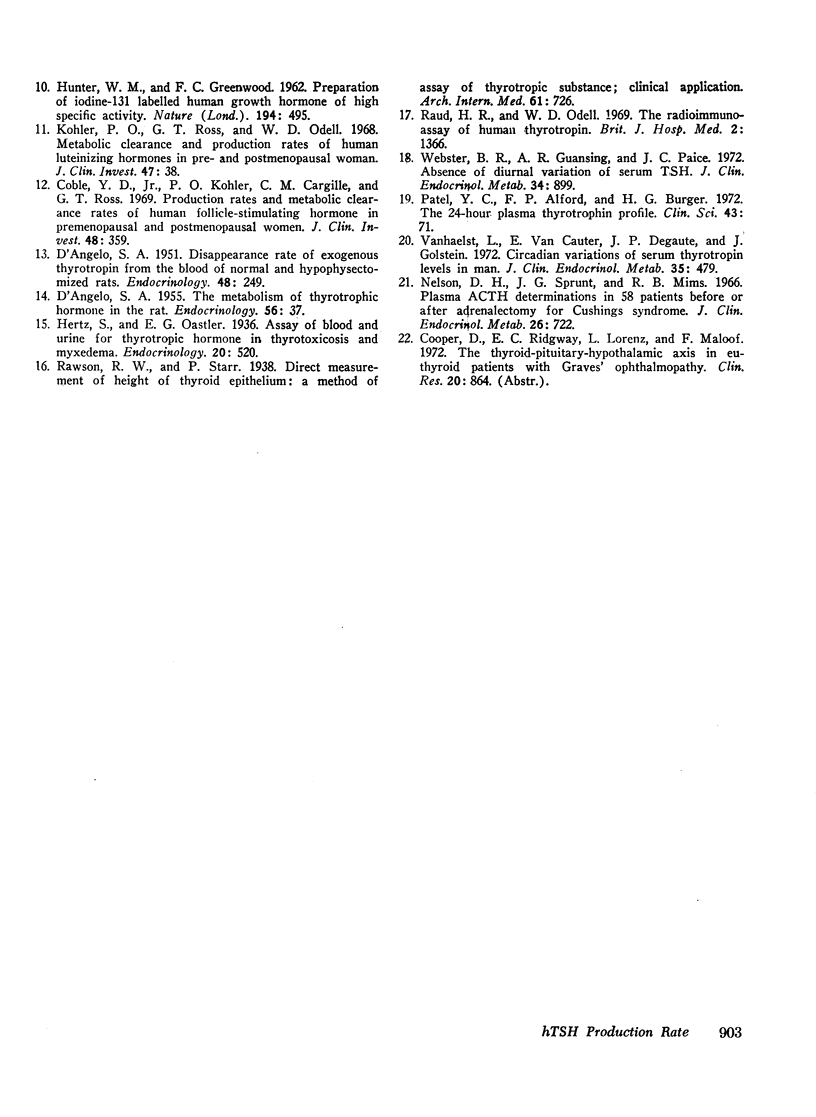
Selected References
These references are in PubMed. This may not be the complete list of references from this article.
- BAKKE J., LAWRENCE N., ROY S. Disappearance rate of exogenous thyroid-stimulating hormone (TSH) in man. J Clin Endocrinol Metab. 1962 Apr;22:352–363. doi: 10.1210/jcem-22-4-352. [DOI] [PubMed] [Google Scholar]
- Beckers C., Machiels J., Soyez C., Cornette C. Metabolic clearance rate and production rate of thyroid-stimulating hormone in man. Horm Metab Res. 1971 Jan;3(1):34–36. doi: 10.1055/s-0028-1095044. [DOI] [PubMed] [Google Scholar]
- Coble Y. D., Jr, Kohler P. O., Cargille C. M., Ross G. T. Production rates and metabolic clearance rates of human follicle-stimulating hormone in premenopausal and postmenopausal women. J Clin Invest. 1969 Feb;48(2):359–363. doi: 10.1172/JCI105992. [DOI] [PMC free article] [PubMed] [Google Scholar]
- D'ANGELO S. A. Disappearance rate of exogenous thyrotrophin from the blood of normal and hypophysectomized rats. Endocrinology. 1951 Mar;48(3):249–256. doi: 10.1210/endo-48-3-249. [DOI] [PubMed] [Google Scholar]
- D'ANGELO S. A. The metabolism of thyrotrophic hormone in the rat. Endocrinology. 1955 Jan;56(1):37–45. doi: 10.1210/endo-56-1-37. [DOI] [PubMed] [Google Scholar]
- HUNTER W. M., GREENWOOD F. C. Preparation of iodine-131 labelled human growth hormone of high specific activity. Nature. 1962 May 5;194:495–496. doi: 10.1038/194495a0. [DOI] [PubMed] [Google Scholar]
- Hershman J. M., Pittman J. A., Jr Utility of the radioimmunoassay of serum thyrotrophin in man. Ann Intern Med. 1971 Apr;74(4):481–490. doi: 10.7326/0003-4819-74-4-481. [DOI] [PubMed] [Google Scholar]
- Kohler P. O., Ross G. T., Odell W. D. Metabolic clearance and production rates of human luteinizing hormone in pre- and postmenopausal women. J Clin Invest. 1968 Jan;47(1):38–47. doi: 10.1172/JCI105713. [DOI] [PMC free article] [PubMed] [Google Scholar]
- Mayberry W. E., Gharib H., Bilstad J. M., Sizemore G. W. Radioimmunoassay for human thyrotrophin. Clinical value in patients with normal and abnormal thyroid function. Ann Intern Med. 1971 Apr;74(4):471–480. doi: 10.7326/0003-4819-74-4-471. [DOI] [PubMed] [Google Scholar]
- Nelson D. H., Sprunt J. G., Mims R. B. Plasma ACTH determinations in 58 patients before or after adrenalectomy for Cushing's syndrome. J Clin Endocrinol Metab. 1966 Jul;26(7):722–728. doi: 10.1210/jcem-26-7-722. [DOI] [PubMed] [Google Scholar]
- Odell W. D., Utiger R. D., Wilber J. F., Condliffe P. G. Estimation of the secretion rate of thyrotropin in man. J Clin Invest. 1967 Jun;46(6):953–959. doi: 10.1172/JCI105601. [DOI] [PMC free article] [PubMed] [Google Scholar]
- Odell W. D., Wilber J. F., Utiger R. D. Studies of thyrotropin physiology by means of radioimmunoassay. Recent Prog Horm Res. 1967;23:47–85. doi: 10.1016/b978-1-4831-9826-2.50005-2. [DOI] [PubMed] [Google Scholar]
- Patel Y. C., Alford F. P., Burger H. G. The 24-hour plasma thyrotrophin profile. Clin Sci. 1972 Jul;43(1):71–77. doi: 10.1042/cs0430071. [DOI] [PubMed] [Google Scholar]
- Patel Y. C., Burger H. G., Hudson B. Radioimmunoassay of serum thyrotropin: sensitivity and specificity. J Clin Endocrinol Metab. 1971 Nov;33(5):768–774. doi: 10.1210/jcem-33-5-768. [DOI] [PubMed] [Google Scholar]
- Ridgway E. C., Weintraub B. D., Cevallos J. L., Rack M. C., Maloof F. Suppression of pituitary TSH secretion in the patient with a hyperfunctioning thyroid nodule. J Clin Invest. 1973 Nov;52(11):2783–2792. doi: 10.1172/JCI107474. [DOI] [PMC free article] [PubMed] [Google Scholar]
- Vanhaelst L., Van Cauter E., Degaute J. P., Golstein J. Circadian variations of serum thyrotropin levels in man. J Clin Endocrinol Metab. 1972 Sep;35(3):479–482. doi: 10.1210/jcem-35-3-479. [DOI] [PubMed] [Google Scholar]
- Webster B. R., Guansing A. R., Paice J. C. Absence of diurnal variation of serum TSH. J Clin Endocrinol Metab. 1972 May;34(5):899–901. doi: 10.1210/jcem-34-5-899. [DOI] [PubMed] [Google Scholar]


